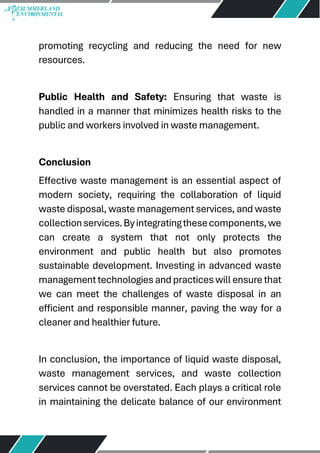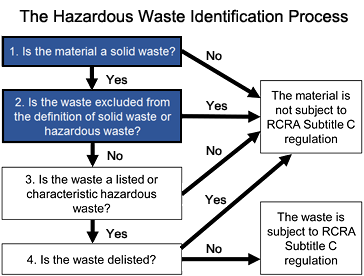The 10-Minute Rule for Reclaim Waste
The 10-Minute Rule for Reclaim Waste
Blog Article
All about Reclaim Waste
Table of ContentsReclaim Waste for BeginnersThe smart Trick of Reclaim Waste That Nobody is Discussing10 Easy Facts About Reclaim Waste ShownThe 9-Minute Rule for Reclaim WasteNot known Facts About Reclaim Waste
Discover the kinds, occurrences, and types of fluid waste. Residential sewer waste describes the waste and items from a household sewage-disposal tank. This kind of waste is produced by people in houses, colleges, and various other structures. This only includes septic tanks that have a drain area. The correct administration and disposal of residential sewage waste require fluid waste to be moved to a sewer therapy plant where the correct approaches and equipment are used to cleanse and get rid of waste.
Industrial waste commonly includes potential risks, such as combustible materials or a combination of fluid and solid waste products, and requires an extra sophisticated and comprehensive disposal process. The disposal of industrial waste commonly involves the filtering of waste prior to transportation to ensure safe and correct disposal. Hazardous waste is created from by-products and runoff of industrial procedures and manufacturing.
This type of waste can not utilize the very same sewage monitoring transportation or procedures as septic or business liquids. The hazardous waste management procedure requires the inspection and testing of fluid waste prior to it undergoes the disposal procedure (liquid waste disposal melbourne). Runoff waste is the fluid waste that comes from runoff and excess stormwater in extremely inhabited areas or cities
Drainage waste can trigger contamination and flooding if not managed properly. Making certain appropriate waste monitoring can avoid catastrophes and decrease environmental damage.
Getting The Reclaim Waste To Work
Call PROS Solutions today to discover about our waste monitoring and disposal solutions and the appropriate means to take care of the fluid waste you create.
(https://ameblo.jp/reclaimwaste1/entry-12874802223.html)Do you know what happens to your water when you draw the plug, purge the commode or drain pipes the cleaning maker? No? Well, it's worth understanding. This so-called 'wastewater' is not only an important resource however, after treatment, will certainly be released to our land, rivers or the ocean. Utilized water from bathrooms, showers, baths, cooking area sinks, washings and commercial procedures is understood as wastewater.

water made use of to cool equipment or clean plant and tools). Stormwater, a form of wastewater, is runoff that streams from agricultural and city areas such as roof coverings, parks, yards, roads, paths and gutters right into stormwater drains pipes, after rain. Stormwater moves untreated straight to local creeks or rivers, at some point reaching the sea.
The Ultimate Guide To Reclaim Waste
In Queensland, most wastewater is dealt with at sewer treatment plants. Wastewater is moved from domestic or commercial websites via a system of sewers and pump stations, called sewerage reticulation, to a sewage treatment plant. City governments develop, keep and run most sewage treatment plants. Operators are licensed under the Environmental Security Act 1994 to release treated wastewater at an appropriate environmental standard right into rivers.
The Department of Natural Resources advises city governments about handling, operating and preserving sewerage systems and treatment plants. In unsewered areas, regional federal governments may need homeowners to set up private or family sewer treatment systems to treat domestic wastewater from toilets, cooking areas, bathrooms and washings. The Department of Natural Resources authorises using home systems when they are verified to be efficient.
In some brand-new neighborhoods, treatment of some stormwater to remove clutter, sand and gravel has started utilizing gross pollutant catches. Wastewater treatment takes place in 4 phases: Gets rid of strong issue.
Wastewater after that flows right into large containers where solids work out and are removed as sludge. Oil and residue are skimmed from the surface. Makes use of tiny living microorganisms referred to as micro-organisms to break down and eliminate continuing to be dissolved wastes and great bits. Micro-organisms and wastes are incorporated in the sludge. Eliminates nitrogen and phosphorus nutrients that can cause algal flowers Recommended Site in our waterways and threaten aquatic life.
Everything about Reclaim Waste
Nutrient elimination is not readily available in all sewage treatment plants because it requires costly specialist tools. It is becoming a lot more common in Queensland. Clear liquid effluent produced after treatment may still contain disease-causing micro-organisms. If this effluent is released right into rivers such as rivers or the sea, the micro-organisms will ultimately pass away out.

Most wastewater flows into the sewage system. Under the Act, regional governments provide approvals and permits for eco appropriate activities (Periods) entailing wastewater releases that may have a local influence.
The 6-Minute Rule for Reclaim Waste
Otherwise, examples are considered research laboratory evaluation. Frequently lots of examinations are required to develop the degrees of each of the different contaminants such as oils, heavy steels and chemicals in water. Surveillance supplies factual info concerning water quality and can verify that permit problems are being fulfilled. The information acquired through tracking gives the basis for making water top quality decisions.
Report this page